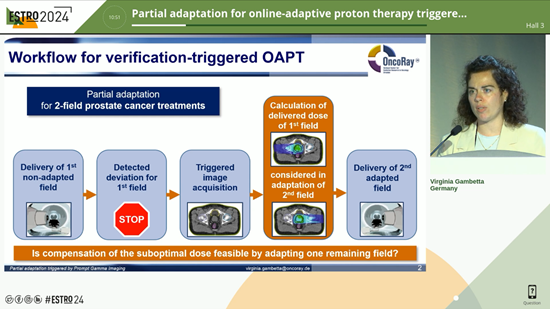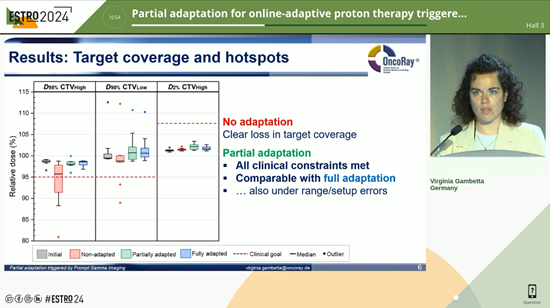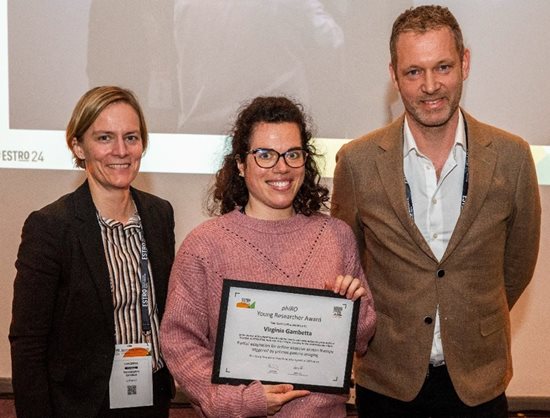Partial adaptation for online-adaptive proton therapy triggered by prompt gamma imaging
ESTRO 2024 Congress report
PGI-triggered instead of upfront evaluation-based online-adaptive proton therapy
The delivery of suboptimal dose distributions in proton therapy, e.g., due to random daily changes in organ filling or their shifts in position, is mitigated nowadays by the adoption of sufficiently large safety margins during treatment planning. These could be reduced in the future through the online adaptation of the treatment plan to the daily imaged anatomy, while the patient is still on the treatment couch. Our vision is to initiate such an online adaptive proton therapy (OAPT) workflow only within those fractions in which the adaptation is deemed really necessary and to omit it completely otherwise, using in-vivo treatment verification data. Treatment verification, for example through the use of prompt gamma imaging (PGI), makes it possible to monitor dose compliance and to detect relevant deviations during delivery. The instantaneous evaluation of PGI verification data, e.g., within the first delivery of the non-adapted treatment field, may then trigger an OAPT workflow for the remaining portion of the plan. Instead of daily upfront imaging and subsequent assessment of the need for adaptation, treatment would begin as usual each day, with the triggering of (partial) online adaptation only. This would not only save time, and therefore increase patient comfort while decreasing costs and humanpower, but would also reduce the imaging dose that would be delivered over the course of treatment and the associated risk of secondary cancers.
Partial adaptation is as good as full adaptation of the initial treatment plan for the most challenging settings
Such in-treatment-triggered workflows would only be convincing if, after the PGI-monitored first field had been delivered, there were no relevant compromises in the overall distribution of dose delivered to the patient after adaptation of the remaining part of the treatment plan only. The strategy of partial adaptation was initially proposed to speed up the standard upfront online adaptation process and was presented in a first proof-of-concept simulation study for head and neck cancer patients [1]. In this work, the online partial adaptation strategy was tested for the first time in the context of a PGI-triggered OAPT in prostate cancer patients. As typical proton therapy treatment plans for such patients consist of two opposing treatment fields, this represents one of the most challenging situations for partial adaptation, given that only one field remains to compensate for any suboptimal dose that might be delivered by the first field.
The study relied on selected in-room CT imaging data from 10 treatment fractions that confirmed differences in rectal filling, femoral head position and/or weight loss. These anatomical changes caused treatment deviations that were detected in retrospectively evaluated PGI data from an ongoing clinical study at OncoRay and that would have triggered an alert for an online adaptation if patients had been treated with smaller safety margins. Indeed, for all fractions, the novel concept of PGI-triggered partial adaptation compensated for the dosimetric influence of anatomical changes and, particularly, ensured that the prescribed dose was delivered to the tumour while healthy organs were spared. Since the results were even as favourable as those observed in an upfront adaptation of the complete plan, which was not anticipated, there would be, in principle, no need to delay the start of daily treatments, as effective adaptive workflows could be initiated at any time should the need arise.
Finally, this work also highlights the value of in-vivo treatment verification to ensure the delivery of optimal proton therapy cancer treatments. This, in conjunction with the partial adaptation concept, represents an important step towards a closed online-adaptive feedback loop.
[1] Gambetta V, Fredriksson A, Menkel S, Richter C, Stützer K. The partial adaptation strategy for online-adaptive proton therapy: A proof of concept study in head and neck cancer patients. Med Phys. 2024;1-10. https://doi.org/10.1002/mp.17178

Envisioned online PGI-triggered partial adaptation workflow on two-field prostate cancer plans; talk given at ESTRO 2024

Envisioned online PGI-triggered partial adaptation workflow on two-field prostate cancer plans; talk given at ESTRO 2024

phiRO Young Researcher Award ceremony, ESTRO 2024
Virginia Gambetta (centre) with phiRO editors, Daniela Thorwarth and Ludwig Muren
Virginia Gambetta
OncoRay – National Center for Radiation Research in Oncology, Faculty of Medicine and University Hospital Carl Gustav Carus, Technische Universität Dresden, Helmholtz-Zentrum Dresden-Rossendorf, Dresden, Germany
virginia.gambetta@oncoray.de, virginia.gambetta@ukdd.de